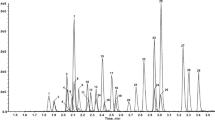Abstract
The reliable analytical method for total morphine in hair was established by GC/MS-SIM. The calibration curve for morphine in hair showed linear over 0.5–100 ng/mg hair. Though the limit of detection was 0.1 ng/mg hair with an S/N >3 of the base ion(m/z 429) for morphine, the limit of confirmation by detection of three major ions was 0.5 ng/mg. The hydrolytic extraction of the morphine analogs in hair with 10% HCl for 1 h at 100° C gave quantitative recovery of morphine. The reproducibility of recovery of morphine spiked to the control hair was 2.9–7.3% in a concentration range between 2 and 50 ng/mg hair. The three monkeys were administered once a day with morphine at 10 mg/kg and heroin at 2.5 mg/kg, respectively, for 10 days and their back hair newly grown for 10 weeks was cut for analysis. The levels of total morphine in monkey hair intoxicated with morphine and heroin were 3.4 and 5.2 ng/mg, respectively. Taking their doses into account, it is concluded that the morphine level in hair from monkeys administered with heroin was 6 times higher than that with morphine. In hair from monkeys and humans intoxicated with heroin, 6-acetylmorphine was detected at the level of 0.7–7.2 ng/mg as a major component in hair together with morphine and no heroin. Drug concentrations of sectional hair shaft cut 2 cm each from the root side were compared with the self-reported drug histories of three cases. The results of sectional analysis of heroin abuser's hair suggested that the relationship between the distribution of morphine along hair shaft and the drug use history showed a good correlation, though the accumulation of heroin metabolites in body could result from chronic use of heroin.
Similar content being viewed by others
References
Baumgartner AM, Jones PF, Baumgartner WA, Black CT (1979) Radioimmunoassay of hair for determining opiate-abuse histories. J Nucl Med 20: 748–752
Cone EJ (1990) Testing human hair for drugs of abuse. I. Individual dose and time profiles of morphine and codeine in plasma, saliva, urine, and beard compared to drug-induced effects on pupils and behavior. JAnal Toxicol 14: 1–7
Fehn J, Megges G (1985) Detection of O6-Monoacetylmorphine in urine samples by GC/MS as evidence for heroin use. J Anal Toxicol 9: 134–138
Franceschin A, Morosini L, Dell' Anna L (1987) Detection of morphine in hair with the Abbott TDX. Clin Chem 33: 2125
Goldberger BA, Caplan YH, Maguire T, Cone EJ (1991) Testing human hair for drugs of abuse. III. Identification of heroin and 6-acetylmorphine as indicators of heroin use. J Anal Toxicol 15: 226–231
Nakahara Y, Takahashi K, Takeda Y, Konuma K, Fukui S, Tokui T (1990) Hair analysis for drugs of abuse II. Hair analysis for monitoring of methamphetamine abuse by stable isotope dilution gas chromatography/mass spectrometry. Forens Sci Int 46: 234–254
Nakahara Y, Shimamine M, Takahashi K, Takeda Y (1991) Hair analysis for drugs of abuse I. Determination of methamphetamine and amphetamine in hair by stable isotope dilution gas chromatography/mass spectrometry method. J Forens Sci 36: 70–78
Nakahara Y, Shimamine M, Takahashi K (1992a) Hair analysis for drugs of abuse III. Movement and stability of methoxyphenamine (as a model compound of methamphetamine) along hair shaft with hair growth. J Anal Toxicol 16: 253–257
Nakahara Y, Ochiai T, Kikura R (1992b) Hair analysis for drugs of abuse. V. The facility of incorporation of cocaine into hair over its major metabolites, benzoylecgonine and ecgonine methylester. Arch Toxicol 66: 446–449
Niwaguchi T, Nakahara Y, Ishii H (1976) Syntheses of various amide derivatives of norlysergic acid and related compounds. Yakugaku Zasshi 96: 673–678
Puschel K, Thomasch P, Arnold W (1983) Opiate level in hair. Forens Sci Int 21: 181–186
Sachs H, Arnold W (1989) Results of comparative determination of morphine in human hair using RIA and GC-MS. J Clin Chem Clin Biochem 27: 873–877
Tagliaro F, Traldi P, Pelli B, Maschio S, Neri C, Marigo M (1987) In: Dev Anal Methods Pharm Biomed Forensic Sci, G. Piemonte Ed. Plenum Publications, NY, pp 115–127
Tagliaro F, Marigo M, Dorizzi R, Rigolin F (1988) Detection of morphine in the hair of opiate addicts with the Abbott TDx: a note of caution. Clin Chem 34: 1365–1366
Valente D, Casshi M, Pigliapochi M, Vansetti G (1981) Hair as the sample in assessing morphine and codeine addiction. Clin Chem 27: 1952–1966
Author information
Authors and Affiliations
Rights and permissions
About this article
Cite this article
Nakahara, Y., Takahashi, K., Shimamine, M. et al. Hair analysis for drugs of abuse. Arch Toxicol 66, 669–674 (1992). https://doi.org/10.1007/BF01981507
Received:
Accepted:
Issue Date:
DOI: https://doi.org/10.1007/BF01981507




